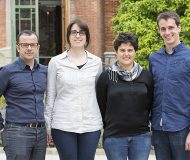

Acute myeloid leukemia is a very heterogeneous disease, the usual treatment is very aggressive and with severe side effects. In the investigation of a new, more effective drug, researchers led by the Oncogenesis and Antitumoral Research Group of the Sant Pau Hospital Research Institute – IIB Sant Pau (Ramon Mangues, Isolda Casanova and Víctor Pallarès) attached to the CIBER-BBN, have demonstrated the efficacy of the self-created nanoparticle that blocks the spread of leukemia cells in animal models of acute myeloid leukemia and directly attacks tumor cells without damaging healthy ones, minimizing adverse effects.
The results of this research, in which the groups from the Autonomous University of Barcelona (Antonio Villaverde and Esther Vázquez) and the José Carreras Leukaemia Research Institute, also from CIBER-BBN, have also participated, have been published in the international scientific journal Journal of Hematology and Oncology.
The researchers have developed a nanofarm that is specifically targeted at leukemia cells, consisting of a nanoparticle bound to a toxin, called auristatin, which is 10 to 100 times more potent than the drugs commonly used in the clinic. As explained by the CIBER-BBN group leader, Ramon Mangues, “we have designed a nanoconjugate thanks to the ICTS Nanbiosis of the CIBER-BBN that targets only the cells that have on their surface a receptor that is over-expressed in leukemia cells called CXCR4. In this way, the particle enters and releases the auristatin into the cells that have this receptor”.
CXCR4 is overexpressed in a high percentage of leukemic cells from patients with poor prognosis or those who have relapsed, which could have a large clinical impact on patients with acute myeloid leukemia. Likewise, this receptor is overexpressed in more than 20 different types of cancer in which it is also associated with a poor prognosis, so it could be evaluated in the future as a possible treatment for other high-prevalence tumours.
Blocks the spread of leukemia cells in non-toxic mice
The designed nanoparticle is able to internalize into the leukemic cells through the CXCR4 receptor and eliminate them. In addition, they have also demonstrated their ability to block the dissemination of leukemia cells in an animal model of mouse without producing any toxicity or adverse effect. Therefore, this drug targeting leukemic cells could help patients with AML who cannot be treated with current drugs because of their high toxicity, such as those who are elderly or have other characteristics not favorable to conventional treatment.
Ramon Mangues also explains that “patients who have developed resistance to the drugs or who have suffered a relapse after being cured could also be treated, as their leukemia cells would have a high expression of the CXCR4 receptor, the target of the nanofarm. Therefore, there is a wide spectrum of patients who could benefit from this new treatment, and these results are of great clinical relevance if their effectiveness is confirmed in future clinical trials”.
Reference article:
An Auristatin Nanoconjugate Targeting CXCR4+ Leukemic Cells Blocks Acute Myeloid Leukemia Dissemination. Victor Pallarès, Ugutz Unzueta, Aïda Falgàs, Laura Sánchez-García, Naroa Serna, Alberto Gallardo, Gordon A Morris, Lorena Alba-Castellón, Patricia Álamo, Jorge Sierra, Antonio Villaverde, Esther Vázquez, Isolda Casanova, Ramon Mangues. 10.1186/s13045-020-00863-9